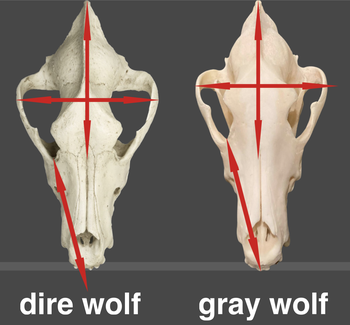dire wolf vs. gray wolf
By Jennifer Stoeckl, MAT - Dire Wolf Project CEO, Feb. 26, 2025
Step back in time to the Ice Age, when mammoths roamed the tundra and saber-toothed cats stalked the frozen landscapes.
In this prehistoric world, two mighty canines hunted their prey:
The legendary dire wolf (Aenocyon dirus)
and
The modern gray wolf’s (Canis lupus) ancestors.
But despite their shared lineage, these two predators had some striking differences.
Especially when you take a closer look at their skulls.
Imagine facing down a dire wolf in its prime.
Its skull alone tells a story of sheer power.
Compared to the sleek, arrow-shaped skull of the modern gray wolf, the dire wolf’s skull is built like a tank.
Broader, more muscular, and designed for brute strength rather than agility.
If a gray wolf is the swift-footed, nimble hunter of the open plains.
The dire wolf is the powerhouse, ready to take down massive prey like bison and prehistoric horses.
Take a look at the image above.
If both skulls were the same length, you'd notice a few key differences right away.
The dire wolf’s occipital bone (the back of the skull) is longer and wider, giving it a stronger foundation for massive jaw muscles.
This means more bite force.
Perfect for crunching through thick Ice Age bones.
Meanwhile, the gray wolf’s occipital bone is narrower, reflecting its lighter, more agile build suited for long chases and precise strikes.
Then there’s the muzzle.
The gray wolf has a long, thin snout—perfect for a swift predator that chases down its meals.
The dire wolf, on the other hand, sports a shorter muzzle with a wider build, allowing for an even stronger grip and crushing power.
It didn’t need to outrun its prey.
It needed to overpower it.
The difference is clear.
The dire wolf was a heavyweight champion of the Ice Age.
While the gray wolf is the quick-footed tactician of today’s wilderness.
Now, fast-forward to modern times.
The Dire Wolf Project aims to bring back the dire wolf’s legendary look in a domesticated dog.
That means capturing the very essence of the dire wolf’s skull—its broad shape, its powerful jaw, its strong foundation.
And we have an incredible example.
Jormu, the Seahorse (now known as Ranger) from the Sea Monsters Litter (Essex/Mary).
With his thick, muscular skull, broad face, and perfect proportions—where his skull length is longer than his muzzle—he embodies the structure we strive for in a DireWolf Dog.
Just like the dire wolves of old, Ranger carries a presence of strength and stability that sets him apart from any modern breed.
Through careful, dedicated breeding, the Dire Wolf Project is reviving the physical presence of the Ice Age’s greatest canine hunter.
The dire wolf may have vanished with the mammoths, but its spirit lives on in the DireWolf Dogs we are creating today.
You can see Jormu (Ranger) on our Pedigree Database and explore photos of dogs going all the way back to the beginning of the breed in 1988!
https://direwolfproject.com/pedigree/7372/
It’s an incredible resource for you to learn all about the extensive work the Dire Wolf Project has been doing for decades.
P.S. If you’re ready to embark on the journey of bringing home your very own DireWolf Dog your adventure begins here.
Just as dire wolves once scouted their icy domain for the perfect territory, we take great care in finding the right pack for each of our pups.
Click the link below to open the Puppy Adoption Questionnaire—your first step in proving yourself as a worthy packmate.
Be sure to answer every question before pressing send, so we can truly understand the heart of your den.
https://direwolfproject.com/puppy-application/
Jennifer Stoeckl is the co-founder of the Dire Wolf Project, founder of the DireWolf Guardians American Dirus Dog Training Program, and owner/operator of DireWolf Dogs of Vallecito. She lives in the beautiful inland northwest among the Ponderosa pine forests with her pack of American Dirus dogs.